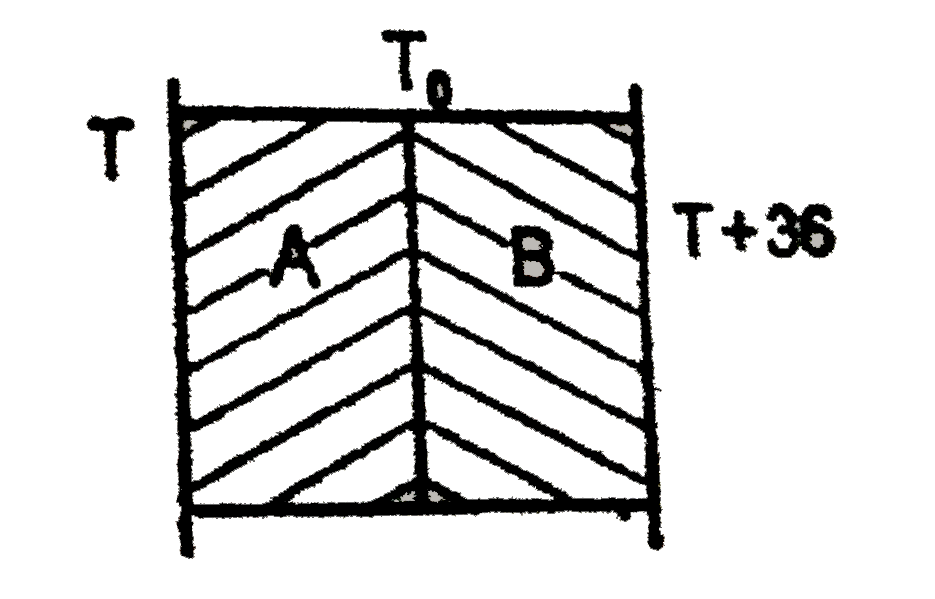A wall has two layers A and B each made of different materials. Both the layers have the same thickness. The thermal conductivity of materials A is twice of B. Under thermal equilibrium temperature difference across the layer B is 36∘C. The temperature difference across layer A is
6∘C
9∘C
18∘C
27∘C
The correct Answer is:B
The two are in series.
KA=3KB
i.e., thermal resistance of A (say RA) is one third that of B (say R8)
i.e., RB=3RA
∴ Thermal current =364RA=9RA
∴ Temperature difference across 'A' =(9RA).RA=9∘C

Topper's Solved these Questions
- BOOK - RESONANCECHAPTER - HEAT TRANSFEREXERCISE - Exercise-31videos
HEAT TRANSFER
- BOOK - RESONANCECHAPTER - HEAT TRANSFEREXERCISE - Advancel Level Problems17videos
HEAT TRANSFER
- BOOK - RESONANCECHAPTER - HEAT TRANSFEREXERCISE - Exercise-21videos
HEAT TRANSFER
- BOOK - RESONANCECHAPTER - GRAVITATIONEXERCISE - Exercise21videos
GRAVITATION
- BOOK - RESONANCECHAPTER - KINEMATICSEXERCISE - Exercise65videos
KINEMATICS
Similar Questions
A partition wall has two layers of different materials A and B in contact with each other. They have the same thickness but the thermal conductivity of layer A is twice that of layer B. At steady state the temperature difference across the layer B is 50 K, then the corresponding difference across the layer A is
View SolutionA wall has two layers A and B each made of different materials. The layer A is 10cm thick and B is 20 cm thick. The thermal conductivity of A is thrice that of B. Under thermal equilibrium temperature difference across the wall is 35∘C. The difference of temperature across the layer A is
View Solution
Knowledge Check
- Question 1 - Select One
A wall has two layers A and B, each made of different material. Both the layers have the same thickness. The thermal conductivity of the meterial of A is twice that of B . Under thermal equilibrium, the temperature difference across the wall is 36∘C. The temperature difference across the layer A is
A6∘CB12∘CC18∘CD24∘C - Question 2 - Select One
A wall has two layers A and B, each made of different material. Both the layers have the same thickness. The thermal conductivity of the material of A is twice that of B . Under thermal equilibrium, the temperature difference across the wall is 36∘C. The temperature difference across the layer A is
A6∘CB12∘CC18∘CD24∘C - Question 3 - Select One
A wall has two layers A and B, each made of different materials. Both layers are of same thickness. But, the thermal conductivity of material A is twice that of B. If, in the steady state, the temperature difference across the wall is 24∘C, then the temperature difference across the layer B is :
A8∘CB12∘CC16∘CD20∘C
A partition wall has two layers A and B, in contact, each made of a different material. They have the same thickness but the thermal conductivity of layer A is twice that of layer B. If the steady state temperature difference across the wall is 60 K, then the corresponding difference across the layer A is
View SolutionA partition wall has two layers of different materials A and B in contact with each other. They have the same thickness but the thermal conductivity of layer A is twice that of layer B. At steady state the temperature difference across the layer B is 50 K, then the corresponding difference across the layer A is
View SolutionA wall has two layers A and B each made of different materials. The thickness of both the layers is the same. The thermal conductivity of A, KA=3KB. The temperature different across the wall is 20∘C in thermal equilibrium
View SolutionA composite slab consists of two parts of equal thickness. The thermal conductivity of one is twice that of the other. What will be the ratio of temperature difference across the two layers in the state of equilibrium ?
View SolutionThe wall with a cavity consists of two layers of brick separated by a layer of air All three lay-ers have the same thickness and the thermal conductivity of the brick is much greater than that of air The left layer is at a higher temperature than the tight layer and steady state condition exists Which of the following graphs perdicts correctly the variation of temperature T with distance d inside the cavity ?.
View Solution

